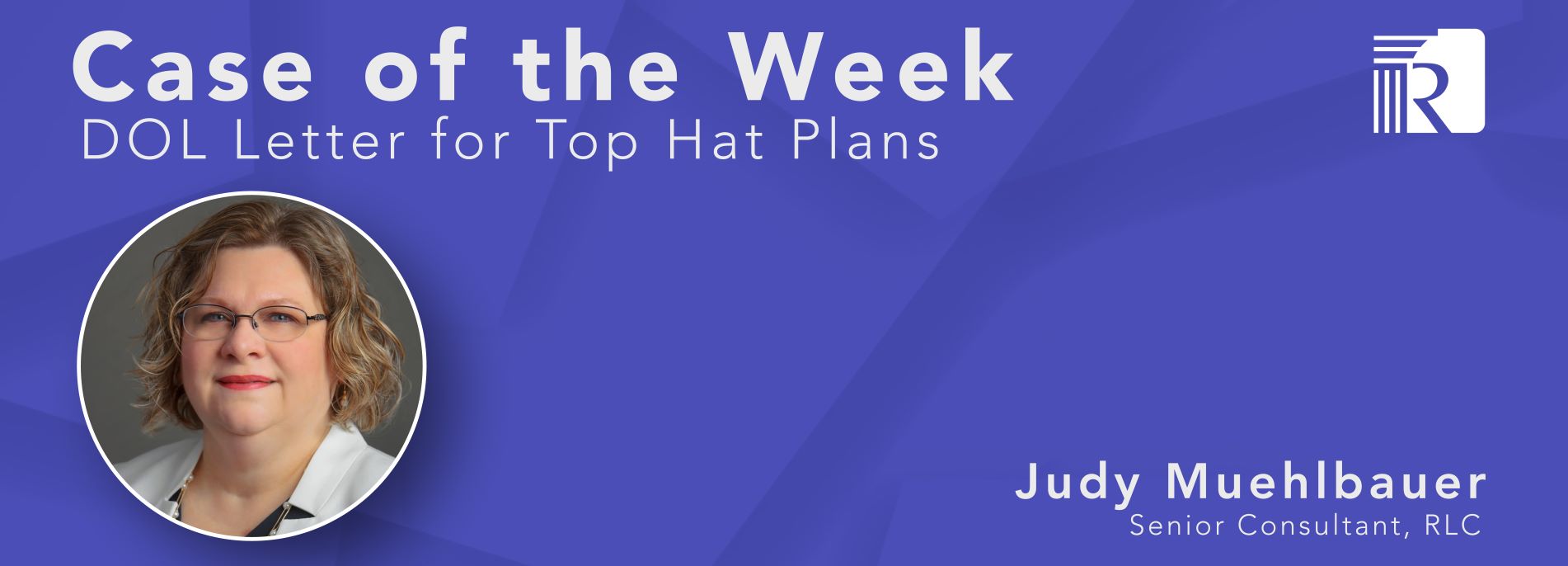
Missing Top-Hat Plan Statement
Nonqualified, top-hat plans must complete a one-time statement filing with the DOL as an alternative means of satisfying reporting requirements. If the Top-Hat Plan Statement goes missing, there are options for plan sponsors.
Welcome to the Retirement Learning Center’s (RLC’s) Case of the Week. Our ERISA consultants regularly receive calls from financial advisors on a broad array of technical topics related to IRAs, qualified retirement plans and other types of retirement savings and income plans, including nonqualified plans, stock options, Social Security and Medicare. This is where we highlight the most relevant topics affecting your business. A recent call with a financial advisor in Massachusetts is representative of a common question on top-hat plans.
"I cannot find a copy of the letter my plan sponsor client was supposed to file with the Department of Labor (DOL) when they started their nonqualified, top-hat plan, should they file one now?"
Highlight of the discussion on the one-time exemption letter for nonqualified plans
Before talking about best practices for dealing with a missing one-time filing with the DOL for a nonqualified plan, it would be appropriate to give a little background about requirements under the Employee Retirement Income Security Act of 1974 (ERISA) as they apply to nonqualified plans. In general, most ERISA requirements do not apply to nonqualified plans as long as they remain “unfunded” and cover only a select group of management and highly paid employees (i.e., a top-hat plan). However, nonqualified plans are not completely exempt from Part 1 of ERISA, which deals with annual reporting requirements.
Although nonqualified plans are not automatically exempt from annual reporting requirements, under DOL Regulation 2520.104-23 the DOL provides an alternative means of satisfying the annual reporting requirement through a one-time exemption letter (i.e., “the Top-Hat Plan Statement”) filed with the DOL within 120 days of starting a nonqualified plan.
The one-time letter must include the name and address of the employer, the employer identification number (EIN) assigned by the IRS, a declaration that the employer maintains a plan or plans primarily for the purpose of providing deferred compensation for a select group of management or highly compensated employees, and a statement of the number of such plans and the number of employees in each plan. In addition, the plan sponsor must agree to provide plan documents to the DOL upon request. Plan sponsors should file this one-time exemption letter electronically with the DOL. You will find instructions for filing the top hat plan statement here: Top Hat Plan Statement.
Because this one-time letter is necessary for a nonqualified plan to be exempt from the annual DOL reporting requirements, a plan sponsor should always retain a copy of the letter in their nonqualified plan file in case of audit. However, returning to the caller’s original question, if a plan sponsor cannot find a copy of the letter, should they file another letter with the DOL? Perhaps, but not before they check the DOL search engine (“Search Top Hat Plan Statements”) for top-hat plan statements to rule out the letter was filed with the DOL, rather than simply misplaced.
If all attempts to locate the one-time exemption letter fail, it is possible to correct the error through the DOL’s Delinquent Filer Voluntary Compliance Program (DFVCP). There is a $750 charge for all top-hat plan corrections submitted through the DFVCP. In addition, because this is a correction, the filer also must submit a DFVCP filing. See Question 18 in following link for instructions on how to file both electronic and paper corrections for top-hat plan filing failures. Frequently Asked Questions about the Delinquent Filer Voluntary Correction Program.
Conclusion
Although there is a $750 fee for correcting a failure to file a one-time top-hat plan exemption letter, this is a bargain compared to the plan being subject to penalties for failing to report annually and the disentitlement of the nonqualified plan, which would result in retroactive taxes and penalties for the plan participants. However, before spending the $750 to correct a failure, always check the Top-Hat Plan Statement search engine first to be sure that the DOL does not already have an exemption letter on file.
